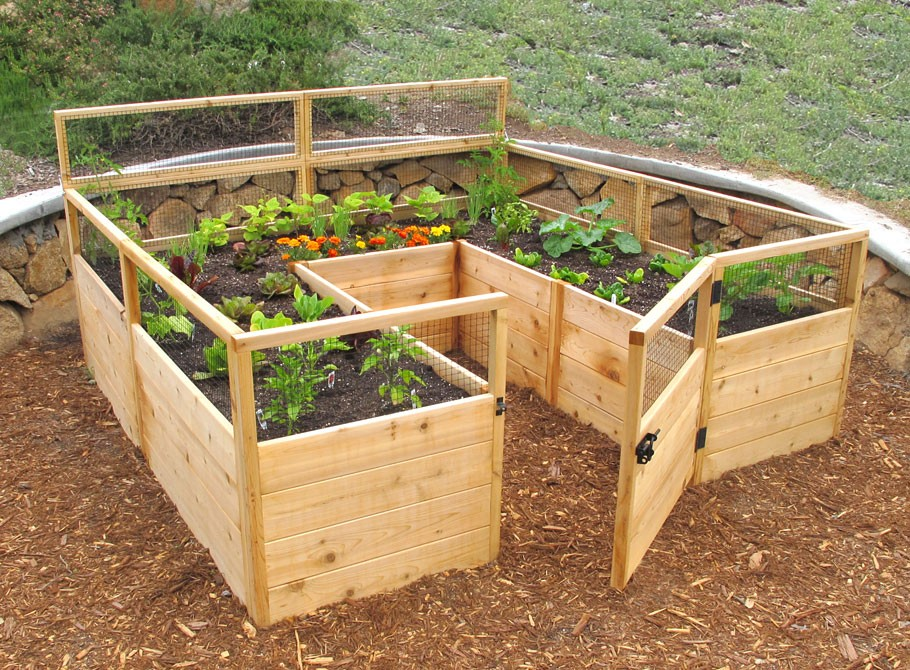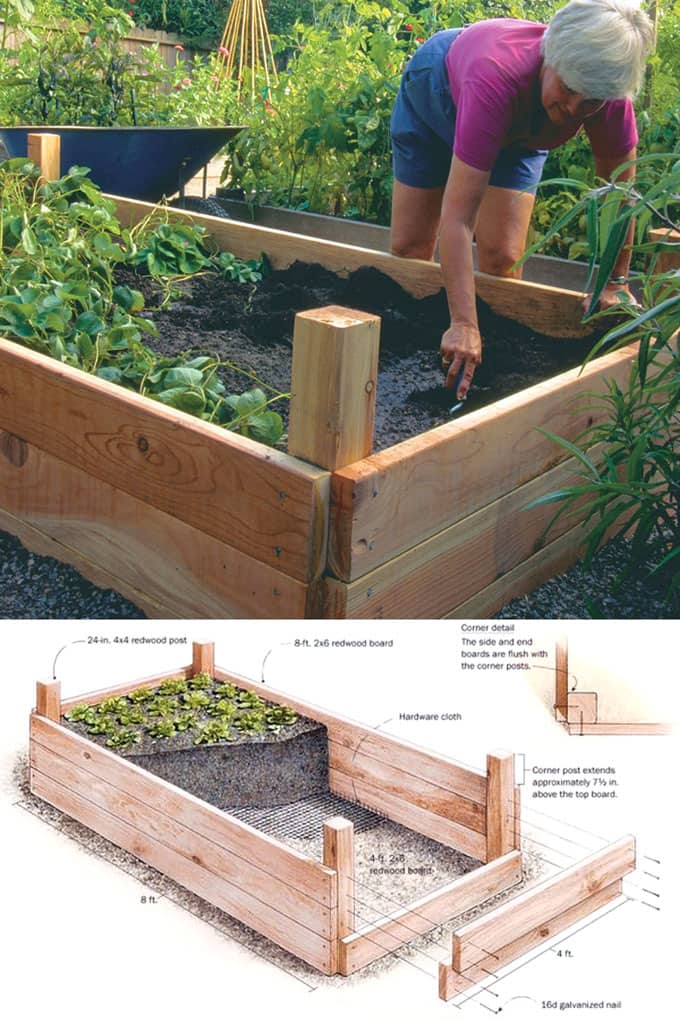How to build a backyard garden
Gardening is not only a relaxing activity for many, but it is also very fulfilling in terms of the results (the food you grow yourself tastes better!) Gardening can be fairly complicated, which is why we’ll be taking it one step at a time and give you tips on how to build a backyard garden.
When building your backyard garden, you want to consider what vegetables and fruits you want to plant and how much space you have for each. If planning this from scratch it can be daunting and time consuming. You can break down the task of building a backyard garden into three steps.

How to build a backyard garden
This article will help you learn how to start a vegetable garden in your backyard, build a raised garden bed cheap and make it look good, and grow different types of vegetables.
How to Start a Vegetable Garden in Your Backyard
You don’t have to have a lot of space or money to have an amazing vegetable garden. You can start with just one square foot of dirt and build up from there. The first step is choosing what type of veggies you want to grow. You can find out which ones will grow well in your area by checking with your local extension office.
Once you know what you want to grow, it’s time for preparation. Remove rocks and loose soil from the area that will become your garden bed. Then add compost or manure (or both) to add nutrients for growing healthy plants. Finally, till the soil so that it is loose enough for planting seeds or seedlings but not too soft so that it will be easy for them to dig into when they need water or nutrients from below ground level.
Next comes preparing the seed itself. The best way is by starting seeds indoors under lights so that they get enough light before being planted outside where they
With a little planning and the right tools, you can build a vegetable garden in your backyard. If you have the space and want to grow your own food, backyard gardens are an affordable way to do it.
A raised bed is a great option for beginning gardeners because it’s easier to work with than soil that’s been dug up and relocated. You can also create raised beds using materials like bricks or blocks to keep the soil elevated.
Here are some tips for building a garden bed that will last:
Pick a sunny spot in your yard where you’ll be able to see what’s going on with your plants easily — if you’re growing vegetables, they need at least six hours of sunlight each day. The sunnier the spot, the better!
Supply yourself with good-quality soil — preferably composted manure or compost from green waste bins collected by local councils — and then mix it with any other organic material available (like straw or shredded paper) before building your garden bed. Fill any holes left by rocks or tree roots with this mixture as well; this will help prevent weeds from growing through the surface of your new creation later on down the track.

Use posts or stakes in the ground around your new bed
If you’re new to gardening, it can be overwhelming to figure out where to start. But don’t worry — we’re here to help.
With a little research and planning, you can grow your own food right at home in your backyard. In this article, we’ll show you how to build a raised garden bed and start growing your own vegetables and herbs.
1. Choose the location of your garden
The first thing you need to do before building a raised bed is decide where it should go. Since the bed will be sitting on top of the ground, it needs to be placed in an area where it won’t get too much direct sunlight or shade from trees or buildings; this means avoiding north-facing slopes or east-facing areas that may get shadowed by buildings during certain parts of the day.
2. Gather materials for building your garden
Once you’ve decided on a location for your raised bed, it’s time to gather materials for building it:
Wooden slats – You’ll need wooden slats that are about 3 inches wide and 1 inch thick (we recommend cedar planks because they resist rot). Lay out all of the pieces on top of each other so they form a rectangle measuring 2 feet by 4 feet (
A vegetable garden is a great way to start growing your own food. It doesn’t take much space, and it’s an easy way to ensure that you have fresh ingredients for your meals.
If you’re interested in starting a vegetable garden, here are some tips for planning the location and layout of your vegetable garden:
Planning Your Vegetable Garden
Consider how much sunlight your backyard receives. Most vegetables need at least six hours of sunlight per day. If you have less than six hours of sun, consider planting shade-tolerant plants like lettuce and spinach or using row covers to protect them from harsh sunlight during the summer months. Or, consider building a greenhouse to give those plants extra protection during the winter months when they may get less sunlight.
Designate an area where water will drain into the soil easily if it rains or snows heavily. This will help prevent waterlogged soil that could prevent roots from absorbing nutrients or harm plants with fungal diseases like root rot or damping off (when new growth collapses). Also, keep in mind where power outlets are located so that you don’t need long extension cords for hoses or sprinklers; this can cause tripping hazards for
Here are some easy tips for building your own garden bed.
1. Start with a base layer of newspaper or cardboard to protect the soil.
2. Add a second layer of newspaper or cardboard on top of the first, then cover it with mulch (wood chips or straw). The mulch will help keep weeds down and keep moisture in the soil.
3. Add composted leaves and grass clippings to enrich your soil, but don’t put meat scraps in your garden — they may attract animals that you don’t want around!
4. Dig holes for your plants deep enough to accommodate their roots but not too deep so that water can drain away easily. Place the plants in their holes, and add more composted leaves or grass clippings around them before filling in the rest of the space with soil.
Raised garden beds are a great way to start a vegetable garden in your backyard. They’re easy to make and can be built with simple materials you probably already have around the house.
Raised beds are also a good option if you have poor soil or drainage, or if your yard isn’t very big.
If you’re new to gardening, this article will help you build your first raised bed. You’ll learn how to start a vegetable garden in your backyard, how to build a raised garden bed cheap, backyard garden vegetables, how to make a raised garden bed, and more.

How to Make a Raised Garden Bed
A raised garden bed is an easy way to grow vegetables, herbs and other plants. Building your own raised bed is a great project for the weekend, and it will make gardening easier and more productive.
If you are new to gardening, here are some things you should know before building a raised garden bed:
What You Need To Build A Raised Garden Bed
You don’t need much in order to build a raised garden bed. The most important things are time and determination. If you are short on either of these, then ask for help from friends or family members who have experience building raised beds. The other supplies you need include:
Plants – Choose from an array of plants like tomatoes, beans or peas depending on where you live and what grows well in your area. When choosing plants for your garden bed, try to mix different types together so that they will cross pollinate each other as they grow and produce fruit or vegetables later on.
Wooden slats (4×4) – These will form the sides of the box once assembled together with nails or screws. You can also use 4×6 slats if desired but be sure that they are straight and solid enough not
If you’re thinking of starting a garden, you might consider building a raised bed. Raised beds are an excellent way to grow your own vegetables and herbs. They’re easy to make and easy to maintain. They also give you the flexibility to create any shape or size that you want.
Raised beds are just what they sound like — garden beds that are raised off the ground on wooden legs or bricks. By raising your plants up off the ground, you reduce their exposure to weeds, pests and disease.
Raised beds are often used in areas where the soil is poor quality or rocky so it’s easier to get good results from them than from directly tilling into the soil without preparing it first.
A raised garden bed can be a great way to add a lot of space to your garden.
If you have limited space, growing vegetables in raised beds is a great option. They are easy to build and allow you to grow more vegetables and flowers than you would in a conventional garden.
A raised garden can be constructed from a variety of materials including wood, cinder blocks or concrete blocks. If you want to make your own raised bed, here’s how:
Planning Your Raised Bed
The first step is planning out what type of material you want to use for your raised bed. You’ll need plenty of room around the outside edge for walking access and enough depth so that plants can grow without needing constant watering. For example, if you’re planting tomatoes then it’s best for them if their roots get about 12 inches deep into the soil so that they don’t need watered every day during dry spells.
You also need to consider how big you want your raised bed to be. This will depend on how much space you have available in your yard as well as whether or not you plan on growing just vegetables or other types of plants as well (such as flowers).
Raised garden beds are a great way to grow vegetables, herbs and flowers. They’re easy to build, don’t take up much space and can be placed anywhere in your yard. You can even move them when you need to reposition them or rotate crops.

Here are 3 tips for building raised garden beds:
1. Raised beds are usually made out of wood, but they can also be built with bricks or stones.
2. You can make raised beds any size you want, but 6 feet long by 3 feet wide is a good starting point. Beds that are 8 feet long by 4 feet wide will give you more growing space and allow you to plant more plants per bed than smaller beds do.
3. The height of the sides of the bed depends on what you want to grow in it and how tall your plants will grow over time. For example, tomatoes should be planted 18 inches deep in the ground; if you place them in a 12-inch deep bed, then they’ll only have 6 inches of soil cover above them instead of 12 inches. That means that if there’s no rain for several days (and there always seems to be no rain for several days), then your tomatoes may dry out because there isn’t.